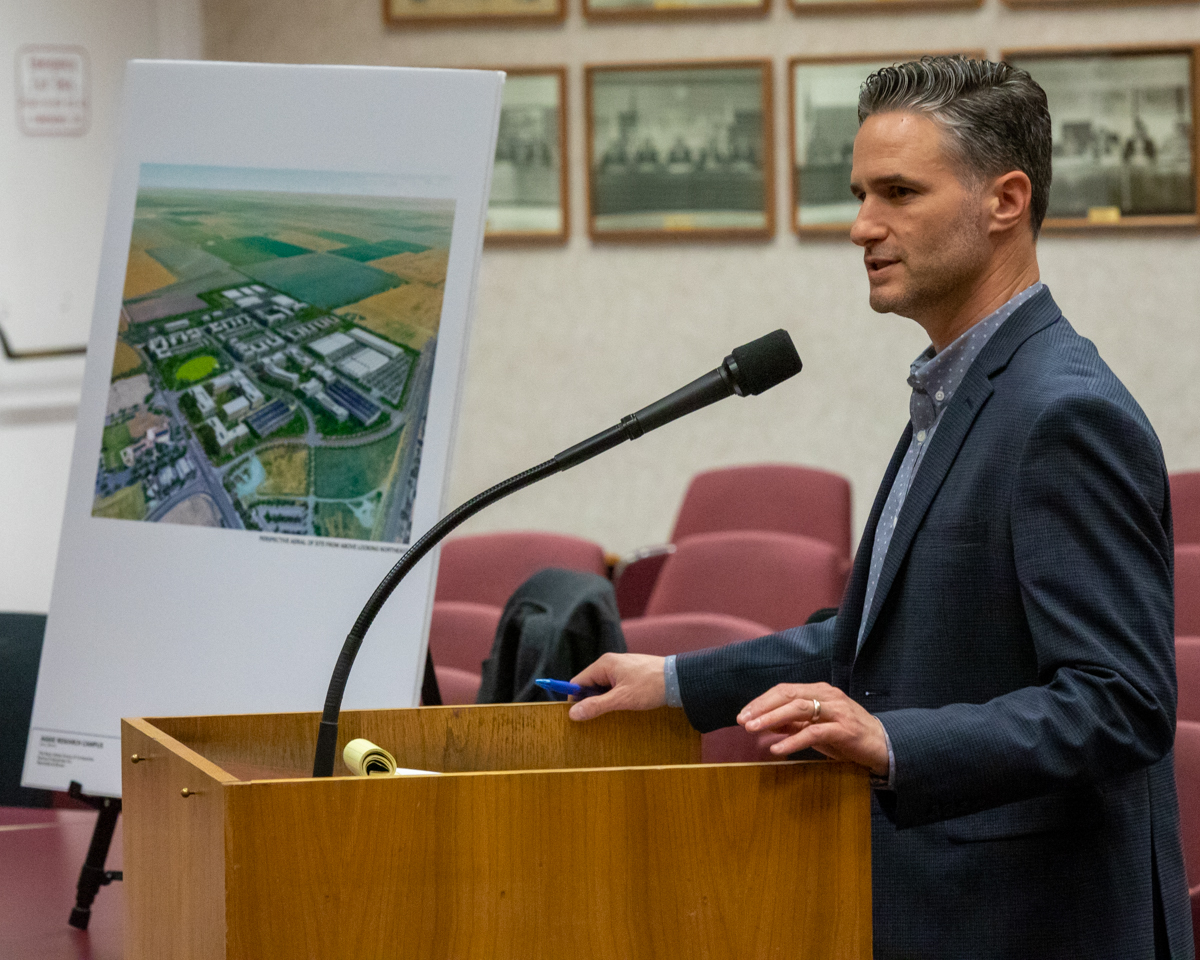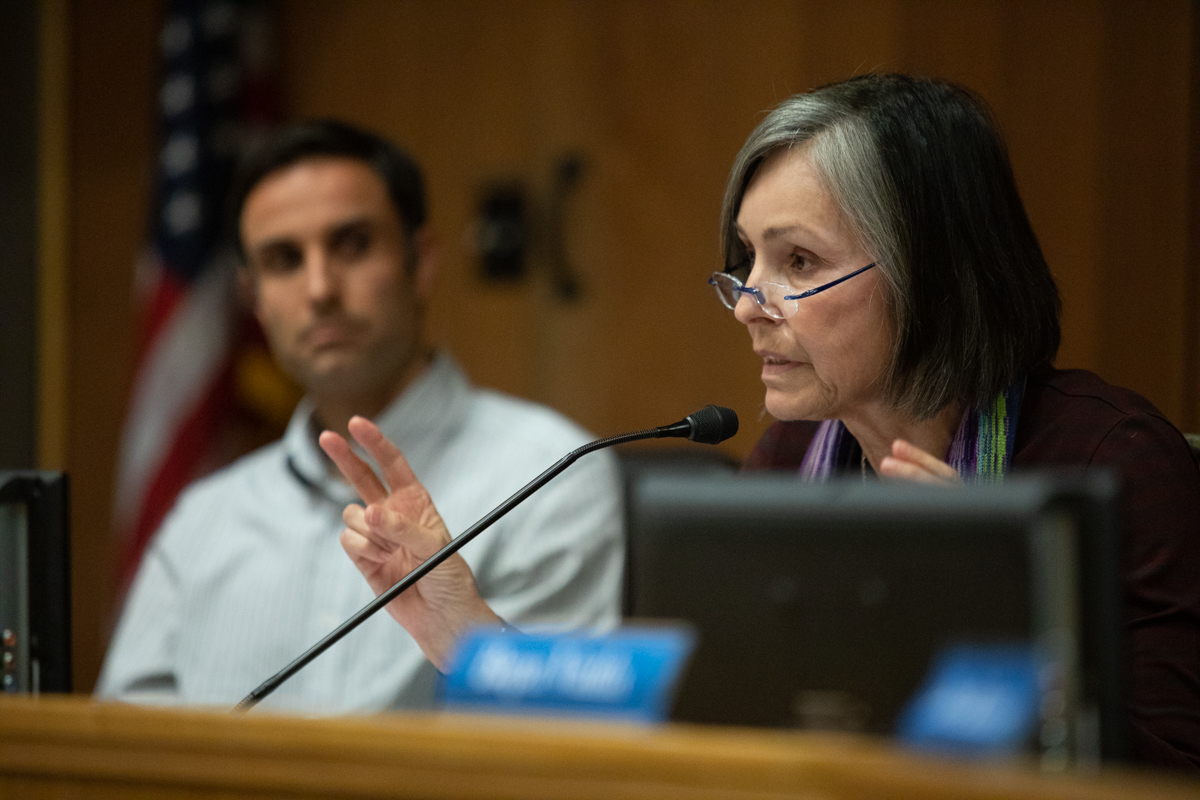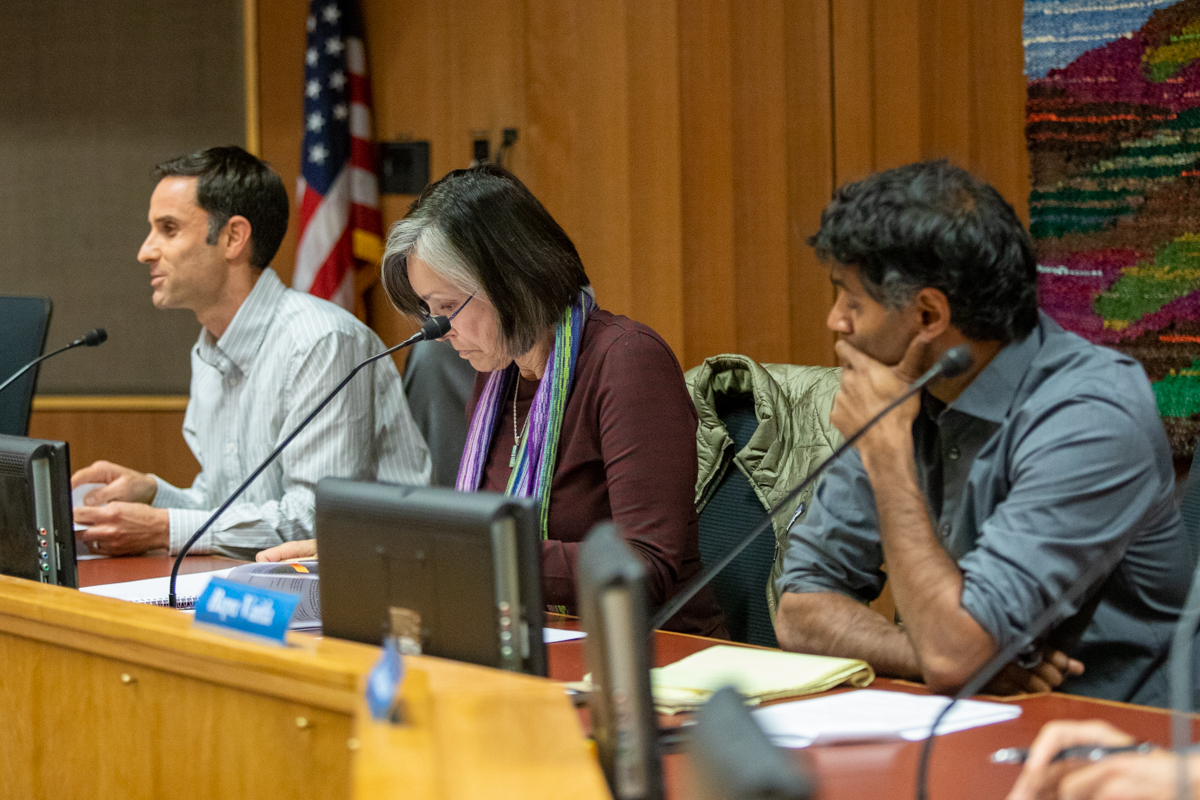

The first step in a long string of advisory board hearings for the Aggie Research Campus, found the Social Services Commission, skeptical that current affordable housing policies are too weak, reject a motion on a 4-3 to accept the staff recommendation to allow the developer to use the current affordable housing guidelines as each portion of the housing proposals come back to council for approval should the project pass a Measure R vote.
Instead, the commission on a motion by Donald Kalman supported on a 5-2 vote a motion that the commission recommends that the city tie the affordable housing requirements to the ordinance at the time when the builders come forward.
The commission was largely unanimous in supporting the strong preference that the developers build their affordable housing onsite.
Ultimately while the commission went away from the staff recommendation, neither staff nor the applicant had a problem with the recommendation.
Part of the challenge is that unlike a traditional housing project, they are not coming forward all at once with a proposal for x-amount of units. Instead, as Matt Keasling attorney for the applicant explained, there could be five or six different housing proposals coming forward over a period of years that would require separate actions.
Sherri Metzker, principal planner for the city, explained, “It isn’t the type of affordable housing proposal that you’re used to seeing.” Later in the evening she would add, “It’s a bit unusual for Davis, but not unusual at all for the development world.”
Mr. Keasling, who presented for the applicants noted that the housing density is 30 units to the acre. “Our density range is 15 to 50 units to the acre, so these are a denser type,” he said noting that one-third would be townhomes as for sale and two-thirds as multi-family. “The type of housing that would be appealing to somebody working at this facility that is looking to have a close proximity to work, probably doesn’t need a car, not a lot of parking, not a lot of yard.”

Mr. Keasling stated that “for purposes of us having some assurances and knowing exactly what we’re working with, we would like to simply adopt the ordinance as it currently stands.”
Sherri Metzker noted that this proposal keeps all the options that a builder has for producing affordable housing, “in play – as opposed to locking in the land owner to one particular aspect. If we keep our options open and keep them flexible, we can figure out what is the best solution at the time of the actual build.”
“What works today, may not work five years from now or ten years from now,” she said. “That’s why we’re in support of the proposal.”
Matt Keasling later stated that they are not home free after a Measure R vote – should it pass. They will have to come back before the council several times to get their housing proposals approved.
“If I had a crystal ball, I think we would have affordable dispersed in our multi-family,” he said. But he also noted that they may have to find other sites to team up with affordable housing developers to help finance a product. “We’re so far from that right now.”
At this time, they want the city to stay, “yes we want an innovation center” and we believe this is the right size and location. “It’s not just trust us the developer, because we’re not home free after we get the Measure – we have to come back for several different entitlements.”
“I know it’s not the story everyone wants in Davis,” he said where they want to hear, that they are building 300 units and to know how they are doing affordable housing. “That’s not this project. We’re building 2.6 million square feet of job creating space and with that 850 housing units at 30 units an acre.”
As he would explain – the 850 units are a cap, but the specifics of what they look like has not been determined yet.
Matt Keasling noted, “Because of our density, it wouldn’t be able to be single family detached.” Ms. Metzker added that normally for single family detached it would be 4 to 6 units per acre rather than a minimum of 15 units per acre.
Don Kalman said, “One concern that I have is that currently I view our current ordinance for affordable housing as very weak.”
He added, “My concern is I think that by tying this to our current ordinance – I think that’s a big problem.” He said, “I’m not in favor of that. I don’t know what the answer is. But I definitely don’t want to tie this to our current ordinance.”

Mayor Brett Lee was on hand and explained to the commission why the affordable housing numbers went from 35 to 15.
He explained that historically, there were redevelopment funds where the state made available pretty sizable proportion of the funds that went to affordable housing.
“Unfortunately, roughly in 2012.. the redevelopment funds were taking away. What used to be there to supplement our fairly aggressive and robust affordable housing ordinance… those matching funds from the state disappeared,” the Mayor said. “Based upon the assumptions that the consultants have used, affordable housing is very difficult to provide at all at 15 percent, let alone at 35 percent.”
Kurt Snipes noted, “I’ve come to feel that 15 percent isn’t enough and the amount of money the city is getting in lieu fees is not enough.” He added, “I’m very uncomfortable locking in something that I’m not even convinced is what we need now.”
Commissioner Anna Ioakimedes suggested that 15 percent was perhaps too low, but 35 seemed very high.
Brett Lee explained that in order to go above 15 percent, the city would be required to explain in great detail their justification. The problem as he explained, “have a high requirement means nothing got built” and he used the Merin County example of many communities that used the high measure to insure that nothing actually got built.
Sherri Metzker noted that the change in the percentage “had to do with the loss of redevelopment funds.”
Chair Georgina Valencia said, “We are being asked to determine whether the rent housing policy we have is sufficient and applicable, because that is the plan that is proposed.”
Ultimately the commission approved an alternative recommendation that if adopted by council, would bind the developers to the affordable housing policies that are in place at the time they seek specific entitlements for housing projects on this site.
—David M. Greenwald reporting








The project developer’s attorney stated “Our density range is 15 to 50 units to the acre, so these are a denser type,”
Ok, so the density is dense. Denser than things that aren’t as dense.
But does that dense density bring affordability? Nope.
The developer is proposing a large amount of housing on the site—a notion that was rejected by Council a couple of years ago—and they came back with a proposal that increased the site acreage devoted to housing from the MRIC Mixed Use Alternative to. Why? Because, as the fiscal analysis released right before the MRIC project was pulled showed, their isn’t sufficient demand for the proposed commercial/industrial uses to make the project feasible.
And now the developer is trying to 1) get away with locking in the current weak interim affordable housing requirements for decades, and 2) not providing the affordable housing on-site.
Richard Rothstein (“The Color of Money”) came to town a few weeks ago to warn us about ongoing patterns of segregation and exclusion, along with the importance of government intervention in the form of strong inclusionary requirements. Will we listen?
In the first sentence of the article you write,
In fact, this project is by far the largest in City history by a factor of at least 4 times and could generate up to 10,000 trips per day yet has incredibly very few Commission meetings scheduled before it is considered by the Planning Commission and Council next Spring before being put on the Novemeber ballot.
Following is the list of Commission meetings scheduled by the City for this project:
Open Space & Habitat – November 4, 2019
Social Services – December 16, 2019 (tentative)
Finance and Budget – February 10, 2020 (tentative)
Bicycling, Transportation, and Street Safety Commission – February 13, 2020 (tentative)
Planning Commission – Spring 2020
City Council – Spring 2020
Measure R Election – November 2020
The Natural Resources Commission is not even scheduled for a hearing even though the City recently declared a climate emergency and the Aggie Research Campus will probably generate more Vehicle Miles Traveled (VMTs) and Greenhouse Gas (GHG) emissions on buildout than any other 5 combined projects built out before in the City.
We have already seen how the applicant is trying to get approvals for its affordable housing plan without even specifying the type of 850 units to be built or even how they will meet their affordable housing approval. This rush to approval without full disclosure or consideration by the Commissions does not bode well for getting a fully disclosed project before the voters.
I do not imagine that this will be a concern brought up by the Vanguard, however.
This is completely absurd, and I hope it will be corrected. Going deeper, the Commission work should be aggregate – but not only in the form of the City Council considering their recommendations at a latter step in the process if there’s a Measure R component, or as a last step: The Commissions should be required to take into account the viewpoint of other Commissions when it makes its own recs. I say “viewpoint” because the sheer number of Commissions and requirements for approval of minutes means that the latter cannot happen in most cases before subsequent review.
While Commissions are certainly able to see the (approved) minutes of previous Commissions – or ideally attend meetings in person as minutes tend to be bereft of nuance – the documents are not included in subsequently-prepared packets. I’d like that it’s very clear and encouraged to reflect on earlier Commission work during subsequent discussion and motions. The same should be clear for citizens who communicate with us before the meetings.
In the case of ARC, the NRC’s common mandate has lots of overlap with the BTSSC’s and this aggregate is automatically ripe. But what about other Commissions? Well, as one example the (quasi-discarded) Beyond Platinum Cycling Plan for Davis goes out of its way to include an “Equity” component, and that and the more recent Climate declaration direct a comprehensive and holistic approach. So this means that e.g. during its discussions the Social Services Commission would reference BTSSC comments and any votes about providing mobility options. (This would also mean that e.g. the approval of the bike share program should have come to Social Services… and for these wide and also narrower reasons the NRC…)
At the multi-Commission-focused meeting of the Downtown Plan earlier this month I recall a Planning Commissioner yelling across the room that they’d to work with the BTSSC and other Commissions. There need to be joint Commission meetings. Going further still, I like the idea of a kind of “Super-Commission” – composed of reps from multiple broadly-relevant Commissions – that would review large and Measure R-applicable projects at the very beginning, when an application comes in, are even as a prior step, so that they can provide input to the developers and Staff, i.e. to make it known if they think a project is appropriate for Davis.
For my part… I will consider making a motion at the February BTSSC meeting to recommend that the NRC be allowed to look at ARC (if that’s not already approved by that point…).
F*cking paradise.
Alan, is that a Melanie Safka reference?
https://m.media-amazon.com/images/I/81qth0OxCoL._SS500_.jpg
Hilarious. Can it be within earshot of a major freeway, as well?
(Which actually encourages an easier, outbound freeway commute.)
So is approving an EIR, with no actual proposal established. “Unusual” anywhere, from what I understand.
“So is approving an EIR, with no actual proposal established. “Unusual” anywhere, from what I understand.”
Wrong, on at least two levels.
EIR’s are not “approved”… they are “certified”… EIR’s are disclosure documents, in real, reasonably projected, time.
Certification of an EIR only means the decision-makers have the appropriate environmental information to consider when they approve/conditionally approve/deny a project.
I’m aware of all of that.
Nothing that you’ve stated shows that my comment was incorrect – other than using common terminology. It was, in fact, an “unusual” ” approval process, as is the subsequent (ongoing) process. It has been roundly criticized, on here and elsewhere.
As a side note, I’ve attached a link to a document which lists exemptions from EIR’s, for Affordable housing:
https://www.planbayarea.org/resources/ceqa-streamlining-opportunities/ceqa-streamlining-exemptions#Affordable%20Housing%20Exemption
R0n O: yes, in common parlance “certification” of an EIR = “approval” of the EIR. It’s even in the title of this FAQ page :“CEQA Process Flowchart: Consideration and Approval of Final EIR”
http://resources.ca.gov/ceqa/flowchart/lead_agency/Final_Approval.html
edited… the developers are trying to get approval of an EIR for an extremely vague project proposal, and then get Council approval to send to the voters to approve the extremely vague project proposal.
Thanks, Rik.
I’m wondering if there’s any way for the developer to manipulate the proposal, so that they can build 850 units of market-rate housing AND Affordable housing – presumably built by an Affordable housing developer somewhere on the site at some point.
Resulting in a much larger impact (and more than 850 units), which would be exempt from CEQA disclosure – despite the restrictions described in the document I referenced.
Ron – they can’t do what you suggest. But they can do something else. Let’s say they wanted to develop affordable housing on the 25 acre city owned property. They could build a purely affordable housing site without Measure R approval – such projects are exempt.
Yikes! Even worse.
Do you suppose that this is the reason that developers “left out” the 25-acre site, in the latest proposal?
Ron: No, I was just pointing out what the law would permit. Idol speculation. Nothing to do with any actual plan in this case.
Greenwald said:
I don’t know what Ramos has been telling you, but it’s more complicated than that. Here is the actual language from Measure R (City Code 41.01.030 Exemptions):